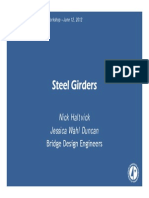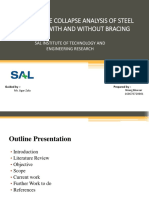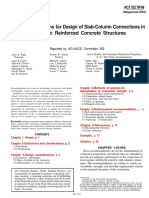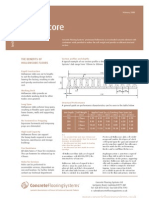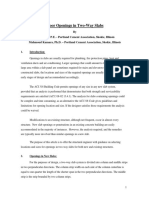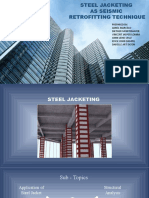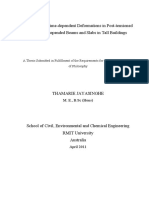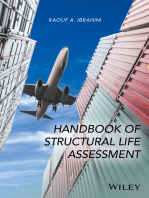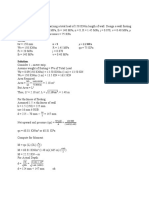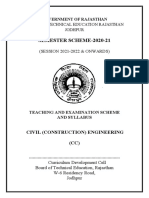Chevron Bracing Details - Steelwise
Chevron Bracing Details - Steelwise
Uploaded by
Eugene AfableCopyright:
Available Formats
Chevron Bracing Details - Steelwise
Chevron Bracing Details - Steelwise
Uploaded by
Eugene AfableOriginal Description:
Copyright
Available Formats
Share this document
Did you find this document useful?
Is this content inappropriate?
Copyright:
Available Formats
Chevron Bracing Details - Steelwise
Chevron Bracing Details - Steelwise
Uploaded by
Eugene AfableCopyright:
Available Formats
steelwise
Horizontal Bracing
By Bo DoWsWell, P.e., Allen Brice, AnD BriAn BlAin
An overview of lateral load resisting systems and how to implement them.
IN MOST COMMERCIaL BUILDINgS, floor and roof diaphragms are used to distribute loads in the horizontal plane of the structure to the lateral load resisting system. Due to the open nature of most industrial structures, diaphragms are not present, and horizontal bracing is often used to distribute the loads in the horizontal plane. Horizontal bracing is also used in heavily-loaded commercial structures, where a diaphragm is not present, or where the strength or stiffness of the diaphragm is not adequate. When horizontal bracing is used, the beams at that elevation become members in a horizontal truss system, carrying axial loads in addition to the normal bending and shear gravity loads. Careful attention should be paid to the beam end connections within the truss system because the axial loads transferring through the connections can be large. Selection of Structural Shapes The most common shapes used for horizontal bracing are single angles and WT-shapes. Single angles are the most economical shape for resisting small and medium loads, because WT-shapes must be split from W-shapes and straightened by the fabricator. WT-shapes can be used to resist larger loads and where long spans are required. Double-angles can be used in lieu of WT-shapes, but corrosion of the steel in the area between the angles can be a problem for exposed structures. If the original protective coating fails, it is difficult to recoat the area between the angles. In exposed
(a)
(b)
Fig. 1: (a) Horizontal diaphragm and (b) bracing systems.
Bo Dowswell, P.E., (left) has been in the steel industry since 1985, spending the first nine of those years as a steel detailer. He is co-founder and principal of SDS Resources LLC, Birmingham, Ala., which specializes in designing steel connections and industrial structures. Allen Brice (right) is senior designer draftsman with more than 20 years experience in structural drafting and design, and Brian Blain is senior account manager. Both are also with SDS Resources.
MODERN STEEL CONSTRUCTION july 2010
structures, stitch plates in double-angle braces should be bolted, due to limited access for welding between the angles. With bolted stitch plates, the angles are bolted together after they have been coated (painted or galvanized). For very large loads, W-shapes can be used. For buildings with very light loads, rod bracing is commonly used. Sometimes, architects prefer the use of HSS when the bracing is exposed to view. In open structures, the member should be rotated to the position that is least likely to collect dust, debris, and/ or rainwater. Angle legs and WT stems usually are oriented downward, and W-shapes normally are designed with the web oriented vertically. Design Considerations Although the dominant load in a horizontal brace is axial load, the effect of bending moments should be accounted for in the design. The moment due to self weight can be significant for long, slender braces. The details of the connections also may result in moments. It is preferable to bolt single-angle braces through the horizontal leg and WT braces through the flange as shown in Figure 2. Because there is an offset between the centroid of the brace and the gusset plate, the eccentric moment, M = Pe, must be accounted for in the member design, and this can significantly lower the member strength. For preliminary design of WT braces connected through the flange, a good starting assumption is that the moment consumes half the strength of a concentrically loaded brace. Because the length-to-depth ratio for horizontal bracing members can be very high, large deflections under self weight are possible. This can lead to large second order moments, and serviceability problems due to sagging of the brace as shown in exaggerated fashion in Figure 3. Also, in industrial structures with vibrating machinery, large lengthto-depth ratios can lead to vibration problems. A rule of thumb that can be used to determine an approximate preliminary brace depth is that the depth in inches should equal or exceed 0.006Fy times the span in ft.
Brace Configurations Bracing is most efficient when placed at angles between 30 and 60. With steeper bevels, the end connections can be cumbersome. Any brace configuration can be used to make up a horizontal bracing system, as long as a complete load path is available to transfer the load into the lateral load resisting system. In most structures, the configuration is a secondary consideration, determined after the location of the main gravity load-carrying members is set. Under most conditions, a single brace system is adequate; however, an x-bracing system can be used to reduce the buckling length of the compression brace in systems with long brace spans. If the braces are designed as a tensioncompression system and are connected at the intersection, the intersection can be considered a brace point for both inplane and out-of-plane buckling. If the braces are designed using a tension-only philosophy, it is recommended that they be connected at the intersection to reduce the possibility of serviceability problems due to the flexibility of the braces. Minus Dimension Horizontal braces typically are not located at the top of steel, because the connections can interfere with grating and decking. To indicate the elevation of the brace, a minus dimension is usually shown on the design drawings. The minus dimension is the distance from the reference elevation (top of steel, top of grating, top of concrete, etc.) to the top of the brace. Theoretically, the best location for the bracing is at the centroid of the beams, because this is where it is located in the structural analysis model (unless offsets are used in the model). However, this usually is not practical, because most structures are built with multiple beam depths within each bay. The minus dimensions are usually determined by the connection details and the depth of filler beams. In practice, the moments caused by the offsets between the brace centroid and beam centroid usually are neglected. The best practice for design drawings is to list the nominal minus dimension, which will allow some flexibility for the detailer to make minor adjustments where beam depths are slightly different within the brace span. A simple example is illustrated in Figure 4 (following page). If the brace is placed 6 in. below the top of steel as shown in Figure 4a, gusset plates are required at the W14 web. The more economical solution is shown in Figure 4b, where the nominal minus dimension is 14 in., and the brace passes under the W14. The W14 filler beam in Figure 4a is more expensive to fabricate due to the gusset plates shop welded to the web. The extra bolts and extra shipping piece for the system in Figure 4a also make the arrangement more expensive to erect. Where braces pass under filler beams, they are usually connected to the bottom flange of the beam with two bolts as shown in Figure 4b. This reduces the buckling length of the brace and acts as a support to reduce the dead load moment and deflection.
Fig. 2: Brace with an eccentric connection.
Fig. 3: sagging brace member.
july 2010 MODERN STEEL CONSTRUCTION
(a) undesirable brace arrangement (b) desirable brace arrangement Fig. 4: Typical plan with horizontal bracing.
Connection Details Figure 5a shows a typical horizontal bracing connection at a beam-to-beam intersection. Where horizontal bracing is located at a beam-to-column intersection, the gusset plate must be cut out around the column as shown in Figure 5b. These are called wrap-around gusset plates. At locations with large columns and heavy beam connection angles, a large area of the gusset plate must be cut out as shown in Figure 6 (opposite page). It is more economical for shops to cut square openings, but the optional diagonal cut shown at the inside corner of the plate can significantly increase the bending strength of the gusset plate legs. The optional cut at the outside corner is used to ensure that the maximum edge distance requirements in the AISC Specification are met. Connections at the gusset-to-beam interface typically
are made with single clip angles on one side of the gusset. Usually the field bolts are easier to access when the clip angles are placed on the top side of the gusset. For larger loads, double clip-angles (one on each side of the gusset) are common. Figure 7 shows a detail where the nominal minus dimension is 14 in. A single clip angle is used to connect the gusset plate to the W18 beam. On the opposite interface, the gusset plate is bolted directly to the flange of the W14 beam. In practice, filler plates are common where the gusset is bolted directly to the beam flange, due to the varying depths of the beams within a braced bay. Gusset plates usually are shop bolted to the brace for shipping to the field. This is more efficient for erection, because the single assembly can be located and oriented easier than if the brace were shipped separately from the
(a) beam-to-beam interface
(b) beam-to-column interface
Fig. 5: standard horizontal brace connections.
MODERN STEEL CONSTRUCTION july 2010
Fig. 6: Wrap-around gusset plate with a large cutout.
Fig. 7 Wrap-around gusset plate bolted to bottom flange of W14 beam.
gussets. On rare occasions, such as where shipping space is at a premium, it may be better to ship the pieces separately so they can be nested. Connection Design Although the force distribution in horizontal brace connections is indeterminate, the gusset-to-beam interface forces can be determined easily. Figure 8 shows a plan view of a horizontal brace connection at a beam-to-beam intersection. The engineer must assign a force path to distribute the axial load in the brace to the gusset-plate to beam-web interfaces. Using a deflection compatibility approach, the interface forces shown in Figure 8a are incorrect because the stiffness parallel to the beam webs is much greater than
the stiffness perpendicular to the beam webs. The small load entering the web in the transverse direction can be neglected, which results in the interface forces shown in Figure 8b. Additionally, the force distribution in Figure 8b uses the simplest and most direct path to get the components of the brace force directly into the beams. Gusset plates are designed so the stresses on any cross section of the plate are lower than the design stresses. The selection of the most highly stressed section is at the discretion of the Engineer-of-Record and is based on judgment and experience. Traditionally, beam equations have been used to determine the stresses at the critical sections, and the normal stress and shear stress are usually considered separately.
(a) incorrect
(b) correct
Fig. 8: Horizontal brace connection with incorrect and correct force distribution.
july 2010 MODERN STEEL CONSTRUCTION
You might also like
- Design and Fabrication of Plywood Curved PanelsDocument32 pagesDesign and Fabrication of Plywood Curved PanelsPatrice AudetNo ratings yet
- Advanced Reinforced Concrete Analysis and Design (2008) - Book. Eng. Mohammed Osama YousefDocument51 pagesAdvanced Reinforced Concrete Analysis and Design (2008) - Book. Eng. Mohammed Osama YousefJulio Humberto Díaz RondánNo ratings yet
- WF To HSS Moment Connections R1 - FINAL PDFDocument7 pagesWF To HSS Moment Connections R1 - FINAL PDFrene_angel1No ratings yet
- 10 Steel DesignDocument57 pages10 Steel DesignSyed Rizwan SaleemNo ratings yet
- Anclajes PeikkoDocument28 pagesAnclajes PeikkopablopelaNo ratings yet
- Designing Compact Gussets With The Uniform Force MethodDocument8 pagesDesigning Compact Gussets With The Uniform Force MethodJonathan Schauder100% (1)
- DR KP-JayaDocument73 pagesDR KP-JayaVinay Sain0% (1)
- Design of Steel and Composite Beams With Web OpeningsDocument19 pagesDesign of Steel and Composite Beams With Web OpeningsAngelica Gamiz ArciniegaNo ratings yet
- Progressive CollapseDocument101 pagesProgressive CollapseVAIDEHI BEAUTY CARE by DEEPA BHAVSAR100% (2)
- CFD Csa A23.3 14Document89 pagesCFD Csa A23.3 14lee100% (2)
- AISC Direct Analysis MethodDocument284 pagesAISC Direct Analysis Methodyoussefayay100% (3)
- Cable Stayed StructuresDocument12 pagesCable Stayed Structuresgene_sparcNo ratings yet
- Rebar - Wikipedia, The Free EncyclopediaDocument7 pagesRebar - Wikipedia, The Free EncyclopediajnmanivannanNo ratings yet
- AISC K FactorDocument30 pagesAISC K FactorEric NolascoNo ratings yet
- Steelwise PDFDocument3 pagesSteelwise PDFFourHorsemenNo ratings yet
- Diaphragm ActionsDocument6 pagesDiaphragm ActionskamakshiNo ratings yet
- STR-M - Joist Girder Moment Connections SJIDocument4 pagesSTR-M - Joist Girder Moment Connections SJIFWICIPNo ratings yet
- 2 Floor Slab Types PDFDocument38 pages2 Floor Slab Types PDFblbloNo ratings yet
- Behavior of Braced FramesDocument12 pagesBehavior of Braced FramesJaime MercadoNo ratings yet
- Investigation of Grouted Dowel Connection For Precast Concrete WaDocument105 pagesInvestigation of Grouted Dowel Connection For Precast Concrete WaOmar Marghani SalmaNo ratings yet
- (Sabelli Et Al. 2013) : Page - 1Document36 pages(Sabelli Et Al. 2013) : Page - 1Harshit NagarNo ratings yet
- Structural AnalysisDocument27 pagesStructural AnalysisKhalid NadeemNo ratings yet
- Behaviour and Stability of Double Coped Beam To Girder Connections Under Combined LoadingDocument12 pagesBehaviour and Stability of Double Coped Beam To Girder Connections Under Combined LoadingKLNo ratings yet
- Plastic Hinge Length of Reinforced Concrete Columns.Document8 pagesPlastic Hinge Length of Reinforced Concrete Columns.nvnrevNo ratings yet
- Davies J M Et Al - The Design of Perforated Cold-Formed Steel SectionsDocument17 pagesDavies J M Et Al - The Design of Perforated Cold-Formed Steel SectionsViorel UngureanuNo ratings yet
- 1505 Column Shortening of Concrete Cores and Composite Columns in A Tall Building PDFDocument7 pages1505 Column Shortening of Concrete Cores and Composite Columns in A Tall Building PDFRejoice Sambo100% (1)
- ACI 3521r - 89 Recommendations For Design of Slab-Column Connections in RCCDocument26 pagesACI 3521r - 89 Recommendations For Design of Slab-Column Connections in RCCVaibhav SengarNo ratings yet
- Gusset Plate Connections For Seismic DesignDocument15 pagesGusset Plate Connections For Seismic DesignIndah Permata YeniNo ratings yet
- 2010 Confinement of Deep Beam Nodal RegionsDocument9 pages2010 Confinement of Deep Beam Nodal RegionsKhNo ratings yet
- Anchoring To MasonryDocument28 pagesAnchoring To MasonryRyan KuntzNo ratings yet
- Impact of Crack Width On Bond Confined and Unconfined RebarDocument10 pagesImpact of Crack Width On Bond Confined and Unconfined RebarbrahmabulNo ratings yet
- Moment Slab For Road BarriersDocument6 pagesMoment Slab For Road BarriersaminjolesNo ratings yet
- Hollow Core Tech DataDocument1 pageHollow Core Tech Datacr231181100% (1)
- SteelWise Strong Connection To HSSDocument4 pagesSteelWise Strong Connection To HSSv100% (2)
- Dynamic Design of Anchors Brochure ASSET DOC LOC 2521843 PDFDocument44 pagesDynamic Design of Anchors Brochure ASSET DOC LOC 2521843 PDFRambo RamosNo ratings yet
- Axial Buckling of Cylinder To ASME89Document8 pagesAxial Buckling of Cylinder To ASME89shakirhamid6687No ratings yet
- Vol34No4 Abrl 2012Document92 pagesVol34No4 Abrl 2012Jorge CifuentesNo ratings yet
- Floor Openings in Two-Way SlabsDocument7 pagesFloor Openings in Two-Way SlabsbasilecoqNo ratings yet
- CHS CorusDocument13 pagesCHS Corusfrog15No ratings yet
- Steel References PDFDocument8 pagesSteel References PDFAlfia BanoNo ratings yet
- Steel Jacket Ppt2Document10 pagesSteel Jacket Ppt2Montemayor, Diether D.100% (1)
- Con 1302Document12 pagesCon 1302Sanket Arun More100% (1)
- Fundamentals of Beam Bracing PDFDocument16 pagesFundamentals of Beam Bracing PDFGautham AllimuthuNo ratings yet
- Biaxial Bending of Steel Angle Section PDFDocument3 pagesBiaxial Bending of Steel Angle Section PDFImam NakhrowiNo ratings yet
- Beam DesignDocument33 pagesBeam DesignstructuresNo ratings yet
- Advanced Steel DesignDocument2 pagesAdvanced Steel DesignIbmWasuserNo ratings yet
- Prediction of Time-Dependent Deformations in Post-Tensioned Concrete Suspended Beams and Slabs in Tall Buildings (T.jayaSINGHE (2011) )Document304 pagesPrediction of Time-Dependent Deformations in Post-Tensioned Concrete Suspended Beams and Slabs in Tall Buildings (T.jayaSINGHE (2011) )Micheline CousinNo ratings yet
- As 2159 Supp1-1996 Piling-Design and Installation-GuidelinesDocument36 pagesAs 2159 Supp1-1996 Piling-Design and Installation-Guidelinesdenis_murphy_15No ratings yet
- Ce609 HW4Document6 pagesCe609 HW4A Bashir Asalai100% (1)
- Seu Digital Library SeurcDocument15 pagesSeu Digital Library Seurcwisnu666No ratings yet
- Cyclic Plasticity of Engineering Materials: Experiments and ModelsFrom EverandCyclic Plasticity of Engineering Materials: Experiments and ModelsNo ratings yet
- Harvesting Freedom: The Life of a Migrant Worker in CanadaFrom EverandHarvesting Freedom: The Life of a Migrant Worker in CanadaNo ratings yet
- Brace ConfigDocument1 pageBrace ConfigmrmerajNo ratings yet
- Additional Truss NotesDocument7 pagesAdditional Truss Notesmdavies20No ratings yet
- Bolted Beam Column ConnectionsDocument16 pagesBolted Beam Column Connectionslael00No ratings yet
- Long Span Beams 2Document14 pagesLong Span Beams 2ashNo ratings yet
- SE Civil Engg. 2019 Patt - 30.062020Document44 pagesSE Civil Engg. 2019 Patt - 30.062020Kalyani ingoleNo ratings yet
- Shear Strengthening of RC Beams With Web-Bonded Continuous Steel PlatesDocument12 pagesShear Strengthening of RC Beams With Web-Bonded Continuous Steel PlatesRachida KrachaiNo ratings yet
- Scopes Projects Nigeria LimitedDocument71 pagesScopes Projects Nigeria LimitedCharles AjayiNo ratings yet
- RCDocument179 pagesRCAngel Engutan100% (2)
- 1946 Shanley The Column Paradox J Aero SciDocument1 page1946 Shanley The Column Paradox J Aero Scitraders joeNo ratings yet
- 286 8 Deflection of Hull StructuresDocument11 pages286 8 Deflection of Hull StructuresJuan SilvaNo ratings yet
- Design Guide 8 - For RHS and CHS Under Fatigue LoadDocument122 pagesDesign Guide 8 - For RHS and CHS Under Fatigue LoadAlberto Ballagas EcheniqueNo ratings yet
- Rockwater V TechnipDocument31 pagesRockwater V TechnipIli SyazwaniNo ratings yet
- NASPEC Information CenterDocument27 pagesNASPEC Information CenterAnonymous ep7LE5ZdP5No ratings yet
- RCD Chapter 8Document4 pagesRCD Chapter 8jereck loquisoNo ratings yet
- Theory-Manual Virtual Bow 2024Document54 pagesTheory-Manual Virtual Bow 2024Abu UmairNo ratings yet
- Ribs & Structure DesignDocument17 pagesRibs & Structure DesignHemanth KathaNo ratings yet
- Zeng 1987Document12 pagesZeng 1987obaidullah.dsuNo ratings yet
- MCE 205 Strength of MaterialsDocument2 pagesMCE 205 Strength of MaterialsKarthiNo ratings yet
- EN1994 5 Hicks Composite SlabDocument42 pagesEN1994 5 Hicks Composite SlaberleosNo ratings yet
- Assignment - 1Document3 pagesAssignment - 1chritNo ratings yet
- Btech 1 Sem Elements of Mechanical Engineering Rme 101 2017 18Document3 pagesBtech 1 Sem Elements of Mechanical Engineering Rme 101 2017 18salman shahNo ratings yet
- Structural Steel Design 1Document22 pagesStructural Steel Design 1Chamil MahagamageNo ratings yet
- Module2 BME EEE20Document38 pagesModule2 BME EEE20Kunal AgrawalNo ratings yet
- TorsionDocument20 pagesTorsionSathish SelvaNo ratings yet
- Strength of Materials Syllabus 1st Sem.2021Document6 pagesStrength of Materials Syllabus 1st Sem.2021Jessa BadilloNo ratings yet
- Gtustudies - FMD IMP Question BankDocument5 pagesGtustudies - FMD IMP Question BankJaideep ZalaNo ratings yet
- WINGDocument94 pagesWINGRaj Manova100% (1)
- Corbel DesignDocument12 pagesCorbel DesignprsscribdNo ratings yet
- Ansys Solution Fall03 PDFDocument83 pagesAnsys Solution Fall03 PDFGuru75No ratings yet
- Semester Scheme-2020-21: (Session 2021-2022 & Onwards)Document101 pagesSemester Scheme-2020-21: (Session 2021-2022 & Onwards)Harshit SaraswatNo ratings yet
- ISSN (Online) : 2451 (WWW - Ijtmsr.in ISSN (Online) : 2451 - 5632 MSR - In) Volume 6, Issue 2, 2020Document4 pagesISSN (Online) : 2451 (WWW - Ijtmsr.in ISSN (Online) : 2451 - 5632 MSR - In) Volume 6, Issue 2, 2020Prakash InturiNo ratings yet



